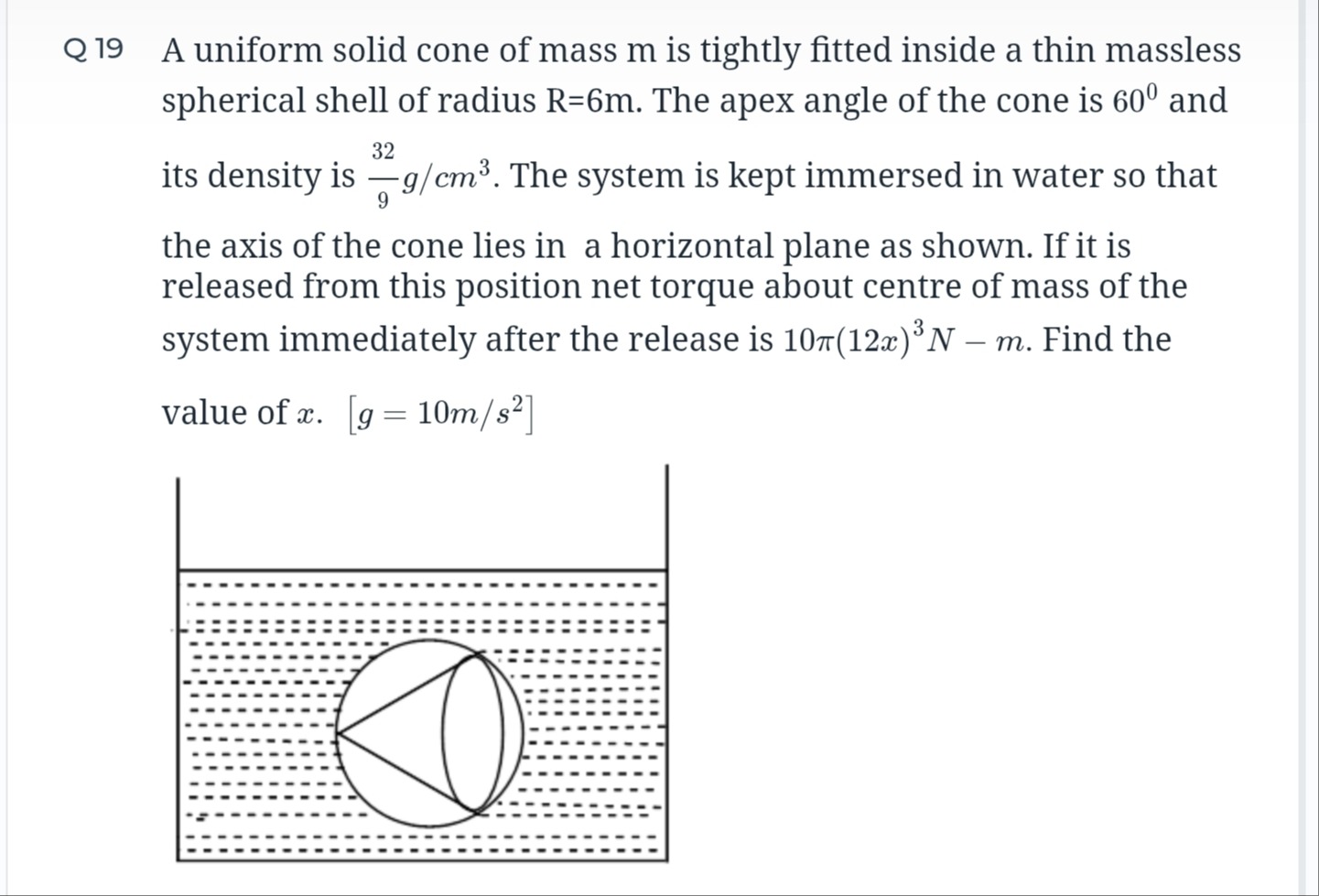Question
Question: A uniform solid cone of mass m is tightly fitted inside a thin massless spherical shell of radius R=...
A uniform solid cone of mass m is tightly fitted inside a thin massless spherical shell of radius R=6m. The apex angle of the cone is 60º and its density is 932g/cm3. The system is kept immersed in water so that the axis of the cone lies in a horizontal plane as shown. If it is released from this position net torque about centre of mass of the system immediately after the release is 10π(12x)3N−m. Find the value of x. [g=10m/s2]

5
Solution
The net torque on the system about its center of mass is due to the buoyant force on the massless spherical shell. The buoyant force on the shell acts at the center of the sphere. The CM of the system (cone + massless shell) is the CM of the cone, which is offset from the center of the sphere. This offset creates a lever arm for the buoyant force on the shell, resulting in a net torque. The weight of the cone and the buoyant force on the cone act at the CM of the cone, hence produce no torque about the CM of the system.
-
Geometry of the cone and shell: The spherical shell has radius R=6 m. The cone has an apex angle of 60∘, meaning the half-angle at the apex is 30∘. Let h be the height of the cone and r be the radius of its base. From trigonometry, r=htan(30∘)=h/3. Since the cone is tightly fitted inside the sphere, its apex and the circumference of its base lie on the sphere. Let the center of the sphere be at the origin (0,0,0) and the cone's axis lie along the x-axis. Let the apex of the cone be at (−R,0,0). The center of the base is at (xB,0,0), and the height is h=xB−(−R)=xB+R, so xB=h−R. A point on the base circle is (xB,r,0). This point lies on the sphere x2+y2+z2=R2. Thus, xB2+r2=R2. Substituting xB=h−R and r2=h2/3: (h−R)2+3h2=R2 h2−2Rh+R2+3h2=R2 34h2−2Rh=0 Since h=0, we get 34h=2R, which gives h=23R. Then, xB=h−R=23R−R=2R. The base radius is r=h/3=233R=23R. The apex is at (−R,0,0) and the base center is at (R/2,0,0).
-
Center of Mass (CM) of the system: The CM of a solid cone is located at a distance h/4 from its base along the axis. The CM of the cone is at xCM,cone=xB−h/4=2R−41(23R)=2R−83R=84R−3R=8R. So, the CM of the cone is at (R/8,0,0). Since the spherical shell is massless, the CM of the system is the CM of the cone, C=(R/8,0,0). This is the pivot point for calculating the torque.
-
Forces acting on the system and their torques: The forces are the weight of the cone and the buoyant forces on the cone and the shell.
- Weight of the cone (W): W=mg, acting downwards from the CM of the cone, C. Since the weight acts at the pivot point, its torque about C is zero.
- Buoyant force on the cone (FB,cone): FB,cone=ρwaterVconeg. The volume of the cone is Vcone=31πr2h=31π(23R)2(23R)=31π43R223R=83πR3. The buoyant force acts at the centroid of the cone's volume, which for a cone is the same as its CM. Thus, FB,cone also acts at C, and its torque about C is zero.
- Buoyant force on the shell (FB,shell): The shell is massless, so its weight is zero. The buoyant force on the shell is FB,shell=ρwaterVsphereg. The volume of the sphere is Vsphere=34πR3. The buoyant force acts at the centroid of the submerged volume of the shell, which is the center of the sphere (0,0,0). The position vector of the point of application of FB,shell relative to the pivot C=(R/8,0,0) is r=(0,0,0)−(R/8,0,0)=(−R/8,0,0). The buoyant force acts vertically upwards. Assuming the z-axis is vertical, FB,shell=(0,0,ρwaterVsphereg). The torque due to FB,shell is τFB,shell=r×FB,shell=(−R/8,0,0)×(0,0,ρwater34πR3g). τFB,shell=(0,8Rρwater34πR3g,0)=(0,6ρwaterπR4g,0).
-
Calculating the net torque and finding x: The net torque about the CM of the system is τnet=τFB,shell=(0,6ρwaterπR4g,0). The magnitude of the net torque is ∣τnet∣=6ρwaterπR4g. Given values: R=6 m, ρwater=1000 kg/m3, g=10 m/s2. ∣τnet∣=61000×π×(6)4×10=61000×π×1296×10=1000×π×216×10=2160000π N-m.
The problem states the net torque is 10π(12x)3 N-m. Equating the two expressions for the torque: 2160000π=10π(12x)3 Divide by 10π: 216000=(12x)3 We know that 216000=216×1000=63×103=(6×10)3=603. So, (12x)3=603. Taking the cube root of both sides: 12x=60 x=1260=5.
